Sustainability Material Issues (Materiality)
Under the Toyoda Precepts (corporate creed), Toyota Industries has been undertaking a broad range of businesses by upholding the philosophy of contributing to society since its founding. In keeping with recent changes in the business environment, we have clarified which social issues we should tackle as our Sustainability Material Issues (Materiality) issues, and will work for the resolution of these issues. We use part of the evaluation on target achievements for initiatives on key Sustainability Material Issues (Materiality) items as a reference index for calculating bonuses for executives.

Process to Determine Sustainability Material Issues (Materiality)

Action Policies, Targets and Results of "Resolving Social Issues through Our Business"
Resolving Social Issues through Our Business

Mitigation of Global Warming
Contribution to Circular Economy
Contribution to Vision 2030 (Aspiration): Clean/zero emissions
Mitigating global warming and achieving a circular economy through such initiatives as reducing CO2 emissions and waste in our business activities and expanding the lineup of environmentally friendly products in our efforts to contribute to maintaining and improving the global environment over the long run
| Action Policies | Action Targets and Activities | Targets for FY 2026 | Results for FY 2025 |
|---|---|---|---|
| Reducing CO2 emissions from production activities | Reduce production-derived CO2 emissions Total emissions | -25% *1 (vs FY14 level) |
-37% |
| Adopt renewable energy sources Introduction rate | 15% | 26% | |
| Reducing CO2 emissions from production-related logistics | Reduce logistics-derived CO2 emissions Emission volume per unit of production (non-consolidated) |
-11% (vs FY14 level) |
-11% |
| Reducing CO2 emissions through product and technology development | Develop technologies that contribute to an even greater level of energy efficiency | - | - |
| Effective resource utilization in production activities | Reduce waste generation volume Emission volume per unit of production (non-consolidated) |
-12% (vs FY14 level) |
-23% |
| Promote water conservation activities corresponding to the water situations in each country and region | - | - | |
| Implementing initiatives to promote 3R(reduce,reuse and recycle) design for effective resource utilization | Reduce use of resources and promote reuse and recycling of resources | - | - |
*1: As a more ambitious target, we are aiming for a 50% reduction by fiscal 2031 from the fiscal 2014 level.
Main Initiatives
Reducing CO2 Emissions by Eliminating High-Pressure Air Systems
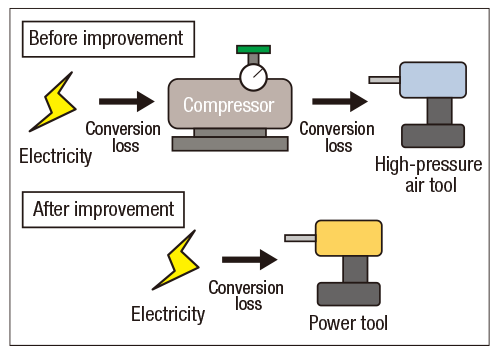
Our Nagakusa Plant, a vehicle assembly base in Aichi Prefecture, is working to reduce CO2 emissions by improving energy efficiency. Compressed air is widely used in factories as a power source for equipment and tools, but generating compressed air consumes electricity, making it less energy-efficient than using electricity directly. Moreover, the higher the compression ratio, the lower the efficiency becomes. In fact, high-pressure air (0.8 MPa*2) was operating at only about 50% efficiency compared to low-pressure air (0.6 MPa).
To address this issue, the plant aimed to generate only the minimum amount of air necessary using the minimum amount of energy, and the high-pressure air system was targeted for elimination. The team first identified all equipment and tools using high-pressure air and systematically switched those that could be adapted to lower pressure or electrified. Equipment that still required high-pressure air was equipped with more energy-efficient booster valves. As a result of these efforts, the high-pressure air system was successfully eliminated, achieving an annual reduction of 494 tons of CO2 emissions.
*2: MPa stands for megapascal, a unit of pressure. 0.8 MPa corresponds to approximately 8 atmospheres.
Conserving Water Resources through Rainwater Storage and Utilization

Toyota Industries Engine India Pvt. Ltd. (TIEI), a consolidated subsidiary in India, is promoting production activities that are considerate of local water resource conditions.
Previously, the company used tap water in its manufacturing processes and air conditioning systems. However, during the filtration process using reverse osmosis (RO) membranes*3, approximately half of the water was discharged as wastewater, resulting in daily tap water usage of up to 60 kL. To reduce tap water usage, the environmental team and the Utility team first considered storing and utilizing rainwater. Rainwater was collected in a pond and tested for quality, which confirmed its suitability for use in air conditioning systems. Additionally, the team explored the use of ultrafiltration (UF) membrane treatment*4, which has a lower wastewater ratio, and confirmed that it met the required quality standards. Based on these results, the company implemented rainwater utilization and switched filtration methods, reducing daily tap water usage by 20 kL, which amounted to annual water savings of approximately 5,280 kL.
*3: A treatment method that uses a filtration membrane with pores of approximately 0.1 nm to remove impurities, allowing only water molecules to pass through.
*4: A treatment method that uses a filtration membrane with pores of 10-100nm to separate macromolecules such as proteins from smaller molecules like ions.

Creation of Innovative Values
Contribution to Vision 2030 (Aspiration): Creation of innovative value, smart
Contributing to achieving a “smart” society and more enriched lifestyles by resolving social issues through technological advancement and innovation that create new values
| Action Policies | Action Targets and Activities | Targets for FY 2031 | Results for FY 2025 | Targets for FY 2026 |
|---|---|---|---|---|
| Promoting development of new technologies that create new values | Ratio of R&D expenses for electrification and automation | Over 70% | 58% | 54% |
| Improving core technologies and utilizing the new knowledge of business partners to enter into peripheral fields of existing businesses while developing and offering technologies and products in new business fields | Expand peripheral fields and new business fields Net sales | Over ¥1 trillion | - | - |
| -Develop new technologies and products that contribute to resolving environmental and social issues | ||||
| -Develop new technologies and products for logistics automation and expand sales (Materials Handling Equipment) Sales of automation products (growth rate) |
Twofold (100%) (vs FY2021) |
Up 85% | Up 98% |
Main Initiatives
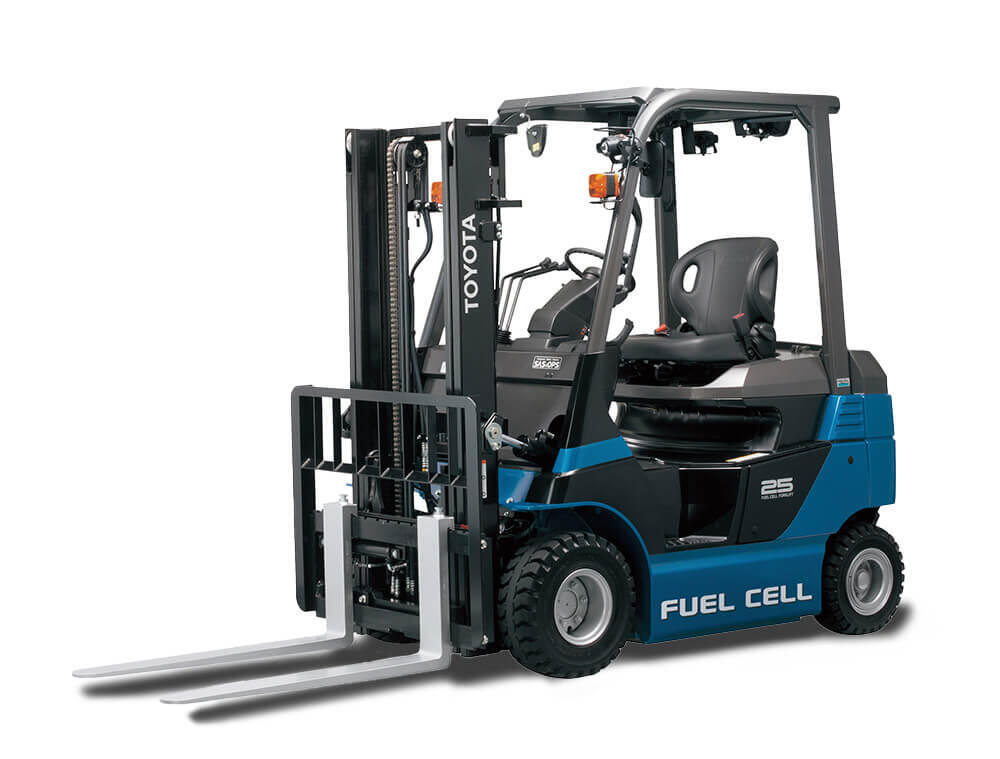
Development and Launch of New Fuel Cell Lift Truck
In September 2024, we launched a new 2.5-ton fuel cell lift truck (FC lift truck) that doubles*5 the durability*6 of the current model and reduces the vehicle price to approximately three-quarters of the original. The FC lift truck features excellent environmental performance, with zero CO2 emitted during operation, and offers high convenience through hydrogen refueling that can be completed in about three minutes, making it a next-generation eco lift truck.
The fuel cell system equipped in the FC lift truck was newly developed based on the system installed in the 1.8-ton model launched in 2022. It delivers a dramatic improvement in durability and a significant reduction in system cost. Since the first launch in Japan in 2016, approximately 450 units have been introduced to customers nationwide with the support of the Ministry of the Environment*7.
Similar to the current model, we aim to expand adoption primarily at sites with long operating hours and high usage frequency, such as factories and airports where hydrogen utilization is expected to grow. Through the spread of FC lift trucks, we will contribute to realizing carbon neutrality and a hydrogen-based society in the logistics industry.
*5: Based on the JIS D6202 engine vehicle fuel consumption test pattern 60S. According to TICO research.
*6: Output performance maintenance period of FC systems (a period during which the output can be maintained at 80% or more of the performance at the time of shipment)
*7: Half of the price difference compared to internal-combustion vehicles is subsidized by the Ministry of the Environment program to promote the decarbonization of industrial vehicles.
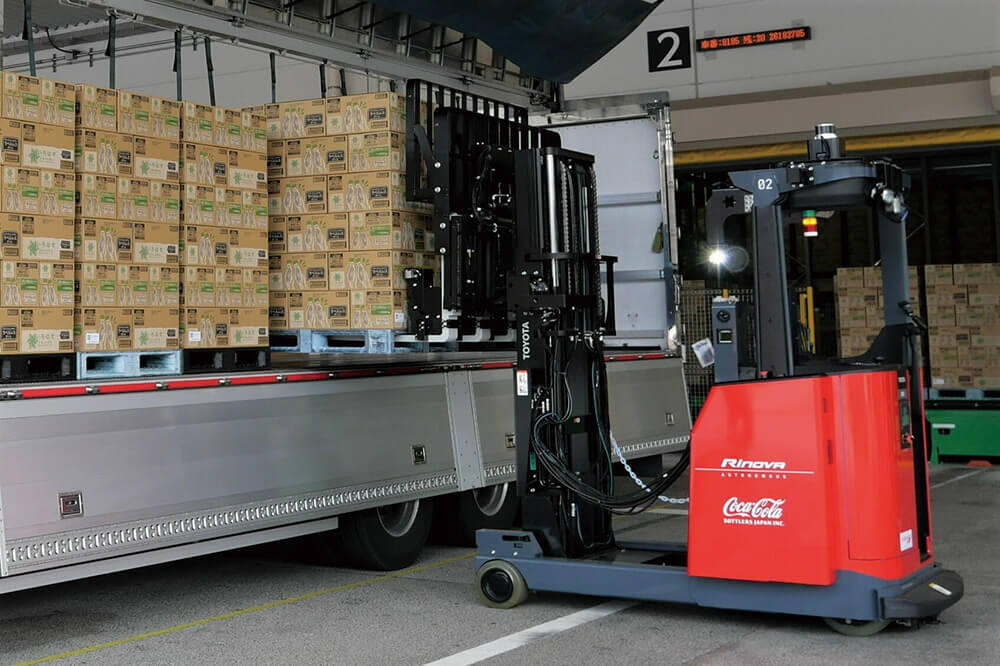
truck loading and unloading
Full-Scale Operation of Japan’s First 4-Fork Autonomous Lift Truck for Truck Loading and Unloading
Coca-Cola Bottlers Japan and TICO conducted feasibility tests of Japan’s first*8 4-fork autonomous lift truck developed by TICO and designed to handle truck loading and unloading. After these tests, full-scale operation began in May 2025. In the beverage industry, it is common to insert forks into two pallets simultaneously for handling and transportation. With the full automation of the 4-fork lift truck, operations such as driving and loading trucks, previously performed by operators, have become completely unmanned, enabling solutions to challenges in shipping systems during busy periods and nighttime operations.
*8: According to TICO research (as of May 9, 2025), this is the first domestic 4-fork automated lift truck with 3D LiDAR that enables truck loading and unloading.
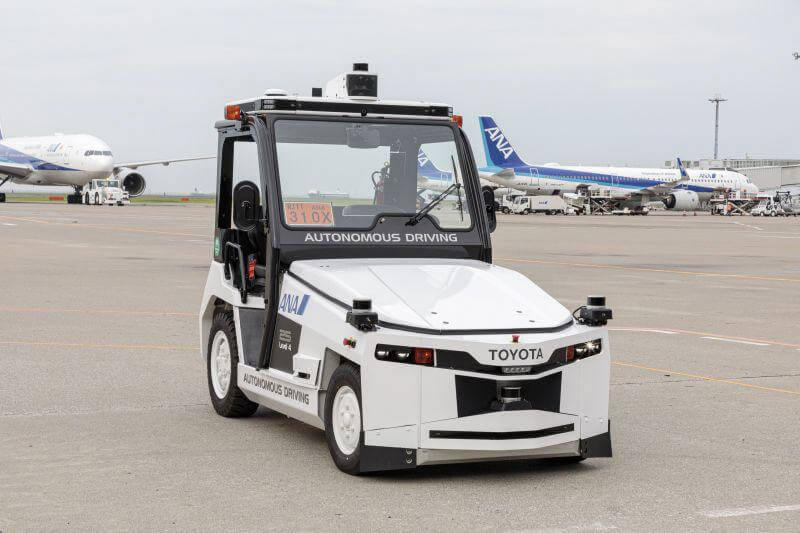
(under development)
Test Operation of Level-4 Autonomous Unmanned Cargo Transportation Conducted Within Airport Restricted Area
All Nippon Airways and TICO conducted a test operation of Level-4*9 autonomous cargo transportation at Tokyo International Airport (Haneda Airport) in July 2024. As part of the Ministry of Land, Infrastructure, Transport and Tourism (MLIT) Civil Aviation Bureau’s aviation innovation initiatives, the two companies are advancing the practical implementation of autonomous towing tractors to address labor shortages in ground handling operations and ensure the sustainable development of airport services. The goal is to achieve unmanned cargo transportation by 2025.
*9: A level of fully autonomous driving under certain conditions in which a system performs all driving tasks.

Products and Services Which Contribute to Safety, Reliability and Comfort
Mutual Prosperity through Partnerships with Local Communities
Contribution to Vision 2030 (Aspiration): Safe/reliable, comfortable
Contributing to creating a compassionate society by offering products and services that anticipate the needs of customers and various stakeholders and that are safe, reliable and comfortable to use while fulfilling our responsibilities as a member of society to thrive together
| Action Policies | Action Targets and Activities | Targets for FY 2031 | Results for FY 2025 | Targets for FY 2026 |
|---|---|---|---|---|
| Expand sales of electrification-related products (all businesses) Ratio of electrification-related products to net sales |
Over 70% | 47% | 49% | |
| Enhancing electrification-related products and services that are highly functional, ecologically sound and adaptable as social infrastructure | -Offer highly efficient and energy-saving electric compressors that are excellent in terms of quiet operation and comfort (Automobile Business) -Offer clean and high-quality fuel cell units and on-board batteries (Automobile and Materials Handling Equipment businesses) -Offer power source-related products, on-board or otherwise, that can also be used as social infrastructure during disasters and other occasions (Automobile Business) |
|||
| Offering high-quality and safe products and services and maintaining and improving the structure to realize this goal | Conduct product risk assessment (target products) Implementation rate (non-consolidated) |
100% | 100% | 100% |
| Continuously promoting grassroots activities in local communities and thrive together as a member of Society | Promote quality education Training participation rate (non-consolidated) |
100% | 94.9% | 100% |
| Promote social contribution activities Expenditure/number of participants | - | ¥1.06 billion/ 35,346 persons |
- | |
| -Contribute to biodiversity conservation of local communities -Promote other community contribution activities |
||||
Main Initiatives
Development of Precious Metal-Free, High-Performance Electrode for Hydrogen Production Equipment by Applying Bipolar Nickel-Metal Hydride Battery Technology to Alkaline Water Electrolysis
The market for hydrogen production equipment, which generates hydrogen from water and electricity, is expected to expand rapidly—reaching approximately 130 times*10 the 2022 level by 2030. This growth requires technologies that enable efficient and stable hydrogen production. Focusing on the alkaline water electrolysis method—one of several hydrogen production methods and an area where our expertise in nickel-metal hydride batteries can be leveraged—we have developed originally designed materials and manufacturing processes for electrodes, the key component in hydrogen production equipment. Using the material and analysis technologies cultivated through the development of on-board batteries (bipolar nickel-metal hydride batteries), we have developed an electrode specifically for alkaline water electrolysis hydrogen production equipment. This electrode is made from a proprietary nickel-based material and contains no precious metals such as platinum, ruthenium, or cobalt. As a result, it is expected to help reduce supply chain risks.
*10: [Source] International Energy Agency (IEA). Cumulative installed capacity is projected to grow from approximately 1 GW in 2022 to about 134 GW by 2030.
Exhibiting at Messe Nagoya 2024
In November 2024, we participated in the Messe Nagoya 2024 exhibition to showcase our initiatives for biodiversity conservation. Our booth featured interactive experiences such as painting decoys (bird models) used in bird conservation activities at the Higashichita Birdpia and a virtual reality (VR) experience of the Animal Path at the Higashiura Plant, both of which are situated in Aichi Prefecture. The exhibition attracted many visitors, providing them with an opportunity to experience the importance of preserving and coexisting with local nature.
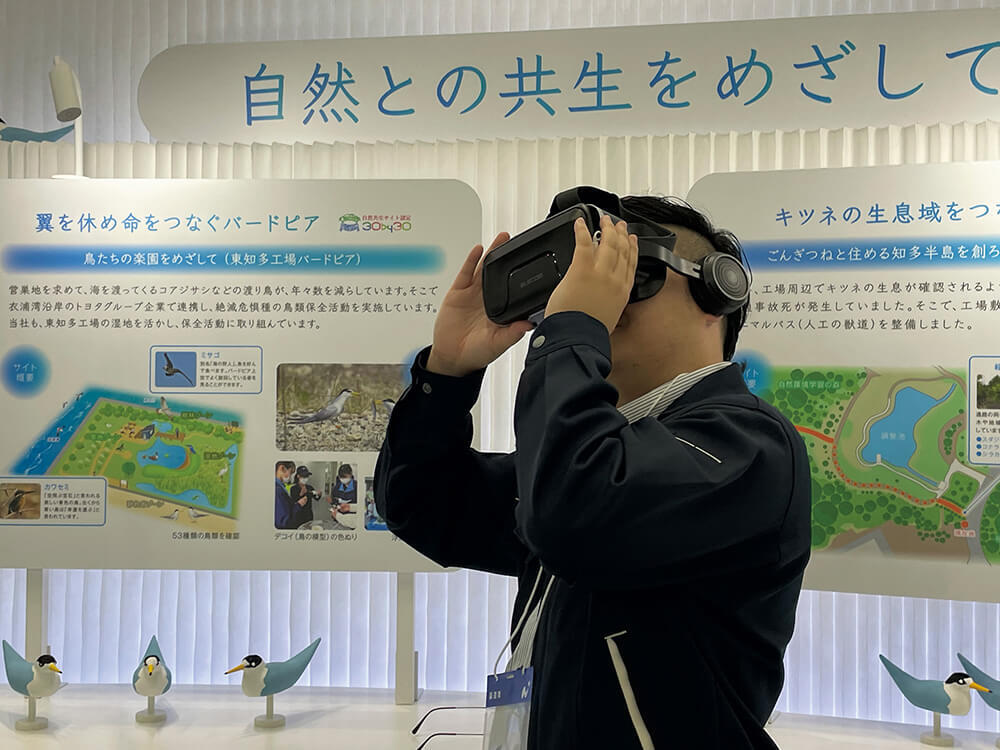
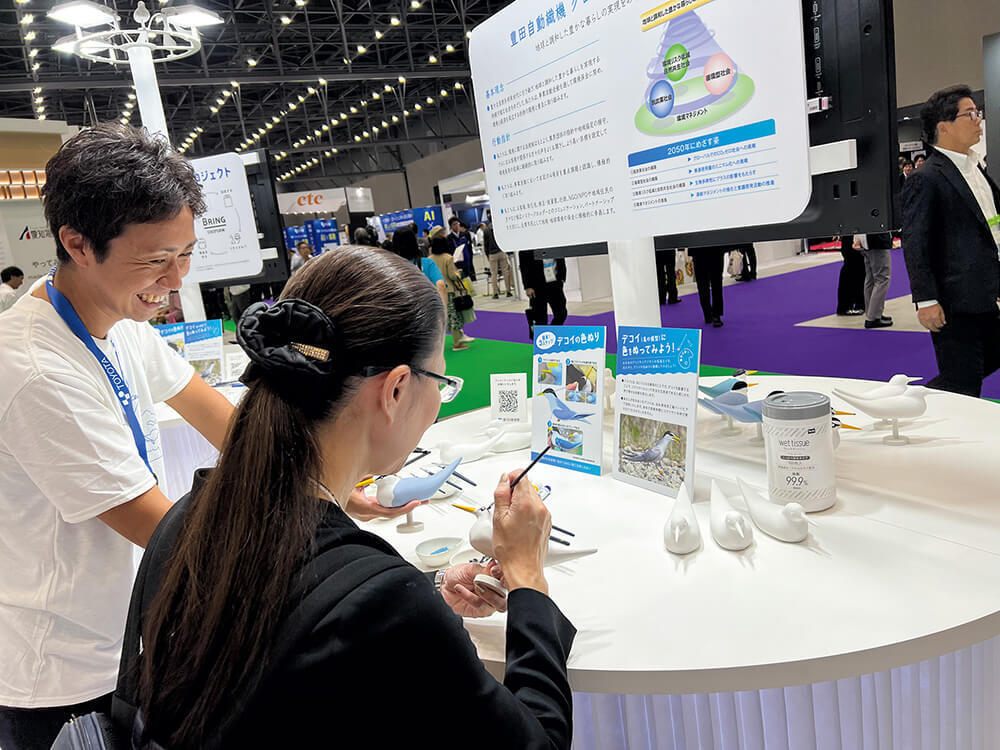
Action Policies, Targets and Results of "Foundation Supporting Our Business Operations"
Foundation Supporting Our Business Operations
Safe and Healthy Work Environments
Leveraging Diversity and Inclusion
Sustainable Procurement
Compliance and Risk Management
| Action Policies | Action Targets and Activities | Targets for FY 2031 | Results for FY 2025 | Targets for FY 2026 |
|---|---|---|---|---|
| Eliminate serious accidents | ||||
| -Number of serious accidents | 0 | 1 | 0 | |
| -Frequency rate of lost workday injuries (non-consolidated) |
0.00 | 0.26 | 0.00 | |
| Fostering safe and healthy workplaces for everyone | Promoting associates’ health | |||
| -Well-being degree (non-consolidated) |
16.0 | 12.4 | 13.3 | |
| -Absenteeism*11(non-consolidated) | Below 0.7 | 1.09% | Below 1.0% | |
| Creating the environment for everyone to get a fair share of opportunities to develop and demonstrate their potential |
Utilize diverse human resources | |||
| -Ratio of female managers (non-consolidated) |
3.6% | 2.17% | - | |
| -Ratio of associates with disabilities (non-consolidated) |
Over 2.7% | 2.68% | Over 2.64% | |
| Maintain sound transactions and strengthen structure throughout the supply chain | ||||
| Establishing the foundation to remain a company that is trusted and needed by society |
-Implementation rate of sustainability checks on target suppliers (non-consolidated) |
100% | 100% (1,118 companies) |
100% |
| Eliminate serious compliance violations Number of violations |
0 | 0 | 0 | |
| Promote risk management activities taking a risk-based approach -Improve BCP effectiveness |
||||
| -Respond to cybersecurity risks Number of serious incidents |
0 | 0 | 0 |
*11: Rate of associates on sick leave for four days or more due to injury or illness
Main Initiatives
Information Security Monitoring and Incident Response
To ensure the early detection of and prompt action against cyberattacks, we have in place systems to monitor the security of PCs and all other terminals used within the TICO Group and to respond to incidents 24 hours a day, 7 days a week. We also share threat information with our consolidated subsidiaries in and outside Japan to swiftly alert each company.
|
Activities in FY2025 • Reinforcing a structure to promote production security |
|---|

